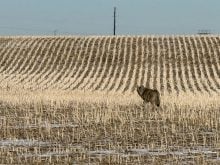This year’s late harvest may mean farmers won’t have time to conduct fall soil tests.
Ten percent of farmers usually test their fields immediately following harvest, said Trish Meyers, an agronomist with Western Co-operative Fertilizers Ltd. in North Battleford, Sask.
But this year there may be a shorter-than-normal time frame to conduct the tests between the end of harvest and first freeze. This will be especially true for farmers in late-seeded areas and those in the northern grain belt where cold weather hits sooner.
If there is time, Meyers encourages farmers to have the tests done, either by a fertilizer dealer or an independent commercial soil tester.
Read Also

Agritechnica Day 3: Hybrid drive for a combine, data standards keep up to tech change and tractors of the year
Agritechnica 2025 Day 3: Hybrid drive for a combine, data standards keep up to tech change and tractors of the year.
The tests are usually conducted in late September and early October.
Soil tests are especially important this year, Meyers said, because the high-yielding prairie crop will likely deplete soil nutrient levels.
She said a common misconception is that soil tests are expensive. The total bill should amount to about $40 per field, added Meyers, who works out of Saskatchewan Wheat Pool’s farm service centre in North Battleford.
The test is mainly designed to determine soil nutrient levels and devise a fertilizer plan for fall or the following spring.
“With low commodity prices, (farmers) are going to be diligent with their fertilizer dollars, so that’s why it’s important to use it as a tool.”
When testing a field, a minimum of 15 soil probes are taken from different locations.
The samples should be taken randomly, avoiding hilltops, depressions, headlands and places like old farmyards where nutrient levels can be skewed. She said 80 percent of the errors in soil tests are attributed to poor sampling procedures.
“I can’t stress enough the importance of taking a good sample.”
Once the samples have been gathered, they are tossed in a bucket and thoroughly mixed. About a litre of this soil stew is sent to a lab for analysis.
Sometimes separate samples are required for different segments of the same field. If a 40-acre zone consistently yields better than the rest of the field, a farmer may want to fertilize that section differently, so it should be sampled separately.
“It’s always nice for the farmer to come along when you’re soil testing,” Meyers said. “He knows his field better than anyone.”
One concern is that a reading conducted in the fall may give different results than one conducted in the spring. Meyers said nitrogen levels are the only readings that may change during that period.
A heavy rain or snowfall after a soil test is conducted could affect nitrogen levels. Another factor is the kind of crop that was planted. As the roots of legumes break down, they release a lot of nitrogen.
If a sample is taken on a field of peas shortly after harvest and there’s another month before the ground freezes, nitrogen levels may rise substantially.
When the results come back from the lab, Meyers recommends the farmer take the printout to an agronomist or certified crop adviser for interpretation. Even though it seems straightforward, there may be questions about timing or application rates.
“You can read a number fine and dandy, but there’s a story to them,” she said.















